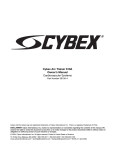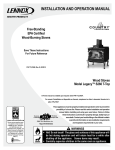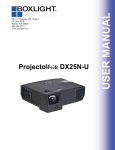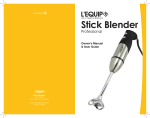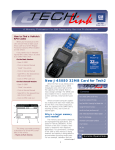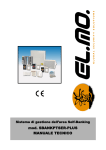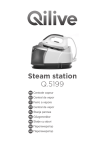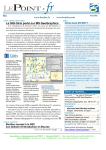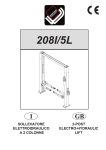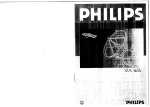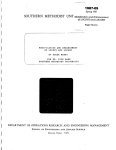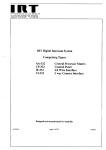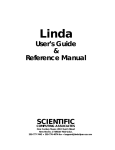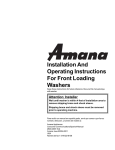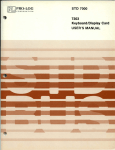Download hardwaresoftware00mcca - Calhoun: The NPS
Transcript
HARDWARE AND SOFTWARE IMPROVEMENTS TO A
PACED DATA ACQUISITION SYSTEM
FOR TURBOMACHINES
Patrick Anthony McCarville
NAVAL POSTGRADUATE SCHOOL
Monterey, California
THESIS
HARDWARE AND SOFTWARE IMPROVEMENTS
TO A PACED DATA ACQUISITION SYSTEM
FOR TURBOMACHINES
by
Patrick Anthony McCarville
June 1981
Thesis Advisor:
R.
P.
Shreeve
Approved for public release; distribution unlimited
SECURITY CLASSIFICATION OF THIS PACE rWhmn Data
Entarad)
READ INSTRUCTIONS
BEFORE COMPLETING FORM
REPORT DOCUMENTATION PAGE
ntromr numTFS
I
TITLE and
4.
2.
GOVT ACCESSION NO
SubtttU)
TYPE OF REPORT
S.
Hardware and Software Improvements to
Paced Data Acquisition System for
Turbomachines
A
PERIOD COVERED
Master's Thesis;
June 1981
a
AUTHOR^
7.
) RECIPIENT'S CATALOG NUMIEft
«
PERFORMING ORG. REPORT NUMBER
I.
CONTRACT OR GRANT
NUMBEMf*,)
Patrick Anthony McCarville
PERFORMING ORGANIZATION NAME AND AOORESS
t.
10.
PROGRAM ELEMENT. PROJECT, TASK
AREA » WORK UNIT NUMBERS
Naval Postgraduate School
Monterey, California 93940
I
CONTROLLING OFFICE NAME AND ADDRESS
1.
12.
Naval Postgraduate School
Monterey, California 93940
MONITORING AGENCY NAME
U.
REPORT DATE
June 1981
IS.
NUMBER OF PAGES
IS.
SECURITY CLASS,
69
* ADDRESS/// dillarant Itom Controlling OHlea)
Naval Postgraduate School
Monterey, California 93940
(ol ihla riport)
Unclassified
IS*.
DECLASSIFICATION/ DOWNGRADING
SCHEOULE
16.
DISTRIBUTION STATEMENT
(ol thl»
Rapart)
Approved for public release; distribution unlimited
17
DISTRIBUTION STATEMENT
IS.
SUPPLEMENTARY NOTES
'»
KEY WORDS
(al tha aaatract antarad in
(Continue an rararaa aid*
II
Sloe* 30.
II
dlllarant tram Rapori)
n«c»»««rr and Identity ay block number)
Programmable; synchronized sampling; digital phase lock loop,
direct memory access
20.
ABSTRACT
(Continue on r«v«r«« aid*
II
neeeaaery
•"<* Identity
or eleek numeet)
Modification of the phase lock loop synchronizing circuits
and of the method of input/output communication used in a synchronized data sampling system, are reported. A device known as
PACER which used an analog phase lock loop for synchronization
and produced a non linear set of synchronizing pulses, was modified
to use a CMOS digital phase lock loop, resulting in a linear set
of pulses.
The associated programming which controlled the data
do
,
:sr7 ,
(Page
1)
1473
EDITION OF NOV ••
S/N 0102-014- StfOl
1
I
IS
OBSOLETE
SECURITY CLASSIFICATION OF THIS PAOE (Whan Data
tnteted)
(«euwty cl*iI'»'C«tiqw q»
Twit
»>w^»»w
r»»»«
«»>«—<
acquisition process and sequencing, was changed to use the
This
direct memory access feature of the system computer.
enabled data, from high response pressure transducers mounted
in a turbomachine, to be taken once every rotor revolution
A user's manual for
rather than once every ten revolutions.
paced data acquisition is included.
Form
DD
1473
Jan 73
S/N 0102-014-6601
1
l*C\J»if*
CLAUDICATION 0'
**!•
piatf**—
°<
Approved for public release; distribution unlimited
Hardware and Software Improvements
to a Paced Data Acquisition System
for Turbomachines
by
Patrick Anthony McCarville
Lieutenant Commander, United States Navy
B.S., University of New Mexico, 1972
Submitted in partial fulfillment of the
requirements for the degree of
iMASTER OF SCIENCE IN AERONAUTICAL ENGINEERING
from the
NAVAL POSTGRADUATE SCHOOL
June 19 81
ABSTRACT
Modification of the phase lock loop synchronizing circuits
and of the method of input/output communication used in a
synchronized data sampling system, are reported.
A device
known as PACER which used an analog phase lock loop for syn-
chronization and produced
a
non linear set of synchronizing
pulses, was modified to use a CMOS digital phase lock loop,
resulting in a linear set of pulses.
The associated program-
ming which controlled the data acquisition process and sequencing,
was changed to use the direct memory access feature of the
system computer.
This enabled data, from high response pressure
transducers mounted in a turbomachine, to be taken once every
rotor revolution rather than once every ten revolutions.
user's manual for paced data acquisition is included.
A
TABLE OF CONTENTS
I.
INTRODUCTION
10
II.
PACED DATA ACQUISITION SYSTEM DESCRIPTION
13
A.
GENERAL DESCRIPTION
13
B.
SYSTEM SOFTWARE
15
C.
1.
RTE-IVB Operating System
15
2.
System Test and Operation Program
16
SYSTEM HARDWARE
17
1.
Hewlett Packard HP21 MX Computer
17
2.
Hewlett Packard HP5610 A A/D Converter
18
3.
PACER
19
III. CHANGES TO PACER HARDWARE
IV.
V.
CHANGE
20
TO ACQUISITION SOFTWARE
22
A.
METHODS OF INPUT/OUTPUT
22
B.
INCORPORATION OF DMA
22
RESULTS
24
A.
LINEARITY TEST
24
B.
AUTO LOCK-ON TEST
25
C.
TEST OF ACQUISITION TIME
25
CONCLUSIONS AND RECOMMENDATIONS
27
APPENDIX A:
HARDWARE DESIGN DETAILS
43
APPENDIX B:
SOFTWARE DETAILS
47
APPENDIX C:
PACED DATA ACQUISITION USERS MANUAL
61
VI.
LIST OF REFERENCES
68
INITIAL DISTRIBUTION LIST
69
5
LIST OF TABLES
I.
CALL EXEC Parameters
29
II.
Data Acquisition Times
30
III.
Components used in PACER
30
C-l
Paced Data Output from Program A2D
65
LIST OF FIGURES
1.
Paced Data Acquisition System Components
31
2.
Schematic of PACER
32
3.
Original and Revised PACER Circuits
33
4.
CD4046 PLL Circuit Detail
34
5.
EXEC CALL Flow Diagram
35
6.
PACER Test Chassis
36
7.
PACER Front Panel
37
8.
Pulse Trains at Counter Bl for Analog
PLL Circuits
&
Digital
38
Paced I/O Request Flow Diagram
39
10.
Data Acquisition and Test Equipment
40
11.
Ramp Test Data from Original PACER
41
12.
Ramp Test Data from Revised PACER
42
CI
Data Acquisition and Test Equipment
66
C2
Cable Connections for Test Data Acquisition
67
9.
LIST OF SYMBOLS AND ABBREVIATIONS
SYMBOLS
A
B
C
F
U
L
D
I
17g
llg
Driver Amplifier
4-Bit binary counter
Comparator
Buffer Amplifier
AND gate
Latching Flip Flop
Delay Flip Flop
Inverter
PACER I/O controller port
A/D I/O controller port
ABBREVIATIONS
A/D
Analog-to-Digital
I/O
Input-Output
RTE
Real-Time Executive
1/Rev
Once per Revolution
1/BL
Once per Blade Passage
PLL
Phase Lock Loop
CMOS
Complementary Metal Oxide Semiconductor
TTL
Transistor-Transistor Logic
DMA
Direct Memory Access
DCPC
Dual Channel Port Controller
TP
Test Point
ACKNOWLEDGEMENT
To my thesis advisor, Dr. Raymond P. Shreeve, goes my
sincere appreciation for his steadfast moral and technical
support.
Without his timely and intuitive guidance, this
project would not have culminated in the results reported
herein.
Secondly, to Mr. Jack King goes credit for the fine
workmanship resulting in the circuits built and tested for
this report.
His expertise in the field of electronics was
an invaluable aid in the completion of this work.
Finally, to Mr. Alan McGuire goes my gratitude for his
most professional work in the drawings and figures completed
for this report.
INTRODUCTION
I.
The device described herein and referred to as the "PACER"
is part of a computer controlled data acquisition system in
use at the Turbopropulsion Laboratory at the U.S. Naval Post-
graduate School.
It is an electronic interface unit built of
solid state and integrated circuit components.
The PACER was
designed to allow the acquisition of data from high response
transducers mounted in the case of rotating machines to be
synchronized with respect to rotor position.
Using the PACER,
the analog to digital conversion of the data from a particular
transducer can be programmed to occur at any position of the
rotor with respect to the transducer, independent of rotor
speed
The PACER was first designed and built in a "bread board"
configuration in 1976 by James C. West as described in Reference (1).
U.S. patent no.
on January 1, 1980.
4,181,962 was issued for the PACER
The present hardware configuration of
PACER involves minor but important changes which improve its
performance and are documented in this report.
The original PACER made it difficult for the typical user
to acquire accurate data in a reasonable amount of time for
the following three reasons:
(1)
The timing pulses generated within PACER were not
always spaced linearly in time between blade pair
10
synchronizing pulses.
This resulted in data which
in some cases was subtly distorted, and in other
cases appeared to have noise riding on it.
(2)
The range over which the PACER could follow rotor
RPM changes and remain synchronized was limited to
approximately + 15% of the initial RPM at which the
PACER was set to take the data.
This required
re-
peated, and somewhat involved, manual adjustment
of an RPM "lock-on" procedure to acquire data at
different speeds.
(3)
The rate at which data could be taken was limited
below the desired rate.
This meant that rather than
being able to sample data on every revolution of the
rotor, the system was only capable of taking data
once every
8
to 10 revolutions, depending on RPM.
The methods used to improve the performance of the PACER
fall into two areas, hardware and software.
Hardware changes
were used to improve PACER linearity, eliminate manual lock-on
procedures, and increase speed-following range.
A change in
acquisition software was used to increase the rate at which
data could be taken.
The change in PACER hardware consisted of replacing the
original analog 562 phase lock loop with a CMOS digital phase
lock loop and eliminating the discrete components forming the
coupling circuit in the PLL feedback path.
The change to
acquisition software involved use of the DMA (direct memory
11
access)
feature of RTE-IVB system software [Ref.
2]
which is
incorporated in the I/O driver written for the PACER.
As a result of the hardware and software changes which
were made, all of the limitations described above were eliminated.
The improvement in PACER performance was verified
using test programs and rotating machine signal simulation
circuits which enabled controlled test techniques to be
employed
In the following section of this report a description of
the entire paced data acquisition system is given.
Section
III describes the changes made to PACER hardware and the
effects of those changes, while Section IV describes the change
to acquisition software.
In Section V the results of the
changes are verified with a report of the system tests.
Sec-
tion VI lists conclusions and recommendations for further
system development.
Appendix A contains detailed hardware
circuit design figures and Appendix B details the software
programs
-
both acquisition FORTRAN and system assembly lan-
guage drivers.
Finally Appendix C is a step by step system
users manual for paced data acquisition.
12
II.
A.
PACED DATA ACQUISITION SYSTEM DESCRIPTION
GENERAL DESCRIPTION
Components of the system are shown schematically in
Figure
1
and details of the circuits, including the modifica-
tions made in the present work are shown in Figures 2-4.
The PACER acts as a secondary controller on the interface
between the Hewlett-Packard HP 21 -MX computer and the A/D
converter.
Referring to Fig.
1,
in a normal
(not paced)
data taking sequence, the 21MX would call on the A/D converter
to take an analog data sample, convert it to digital,
output it to the computer memory.
and
Since the computer program
execution cannot be synchronized to the rotation of the machine
shaft, the data sample would be from a random, unidentified
point.
In a paced data acquisition sequence,
the timing control to the 21MX computer.
the PACER provides
After the 21 MX
computer passes a word (IBLADE) to the PACER defining the
desired position, the PACER acts as an intermediary.
It inter-
cepts the computer command to the A/D converter, tells the
computer that the A/D converter is in the process of acquiring
the data, then sends a command pulse to the A/D converter at
a time
synchronized to the desired position in the cycle of
the rotation of the machine.
13
The sequence of events for paced data acquisition using
the software developed in the present work is as follows:
(1)
The user enters the main program (which was written
to be used for system testing or for data acquisition)
(2)
The main program prompts the user for information
regarding the (rotor) position
to start taking data points.
desired at which
(s)
This information defines
the integer IBLADE
(3)
The main program calls the PACER, passes IBLADE to
the PACER, and receives rotation speed
the PACER.
(4)
(IRPM)
from
Control then returns to the main program.
The main program calls the A/D converter telling it
to take a number of data samples
point).
(N)
(at the desired
When complete, control is returned to the
main program.
(5)
If a survey of positions
of blade passages)
loop,
(for example,
across a pair
has been programmed using a DO
the main program repeats steps
(2)
and (3),
incrementing IBLADE each time until the loop is
finished.
(6)
When all data have been taken and stored in the computer memory, the main program converts the digital
data (which are binary whole numbers) to decimal
values scaled appropriately to the
of the A/D converter.
+1.0 volt range
As programmed,
that data to the desired peripheral
printer, plotter, or terminal)
14
(s)
it then outputs
(i.e.
the
B.
SYSTEM SOFTWARE
The software used in the data acquisition should be viewed
as consisting of two separate parts,
the RTE-IVB operating
system which is generated in-house following standard pro-
cedures supplied by Hewlett-Packard, and the system test and
operation FORTRAN program which may be modified at any time
by the user operating in the RTE-IVB system.
1.
RTE-IVB Operating System
The RTE-IVB (Software) Operating System is generated
(and can be regenerated)
by the System Manager in a process
which "configures" the System for the particular set of (I/O)
devices which the computer must address [Ref.
RTE-IVB
3].
permanently resides on disc and is automatically loaded when
the system is turned on.
It consists of a collection of soft-
ware modules which perform system resource management, operator
requests for utility programs
(FORTRAN compiler,
file editor,
etc.), and user program scheduling for time sharing
[Ref. 4].
RTE-IVB is visible to the user through interaction at the
terminal.
It allows multi-programming through its scheduling
modules so that more than one user's program may be active
at a time.
The input/output (I/O) drivers are a set of
They are the software routines
modules in the RTE-IVB System.
which control the input and output communication between the
user's program and addressed peripheral devices.
The drivers
enable efficient use of peripherals which act at different
speeds by allowing one or more fast I/O requests to be
15
processed while waiting for a request from
device to be completed.
(DVR.70)
a
slow peripheral
A driver written for the PACER
and a driver written for the A/D converter (DVR.56)
are part of RTE-IVB and are listed in Appendix B.
2
.
System Test and Operation Program
The system test and operation program (A2D)
is a
FORTRAN program written and used in the course of the present
work.
A listing and flow diagram are given in Appendix B.
Program A2D converts the user's requests, which are entered
at the terminal,
I/O drivers.
parts.
to the parameters required by the RTE-IVB
It is an interactive program consisting of two
The first part, a system test (subroutine ADTES)
,
is
entered if the user wants to carry out a test of the paced
data acquisition system simply to ensure that all components
are operating correctly.
The second part,
(Subroutine RPACE)
is executed if paced data is to be acquired from a test rig.
Both the "test" and "operation" portions of A2D use the
FORTRAN statement "CALL EXEC" to enter the appropriate driver.
The CALL EXEC statement, with its accompanying parameters,
transfers control from the FORTRAN program to the assembly
language driver for the device requested.
A simplified flow
diagram of the CALL EXEC routine is shown in Figure
5.
The
driver initiates the input or output task as specified in
the parameters which it received.
If the task is for "output",
after the task is initiated control may return to the calling
FORTRAN program or another user's program.
16
If the task
requires "input", then control may be passed to another program, but not back to the calling program,
since the calling
program must have an input value to continue executing.
This
permits efficient use of the computer's time, which is essential for multi-programming, while waiting for a slow peripheral
device to complete its cycle of operation.
C.
SYSTEM HARDWARE
The hardware devices used in paced data acquisition are
the HP-21MX computer with printer,
its magnetic disc, plotter,
and terminal, the HP 5610A A/D converter and the PACER.
1.
Hewlett Packard HP 21 MX Computer
The HP 21 MX is a (Micro-programmable) mini-computer
having 128 machine instructions and 32K of logical main frame
In the present configuration a 20 megabyte capacity
memory.
disc and disc operating system are an integral part of the
A detailed description of the computer is given in
system.
Reference
2.
An important feature which is typical of computers of
this size is the input-output structure.
With a limited
number of relatively slow I/O devices to be serviced, the
computer can communicate with all devices through a single
port known as the I/O bus.
I/O interface on the bus.
Each device requires its own
The interface acts as a filter and
ensures that output information is received only by the device
designated to receive it and that input information is put
17
on the bus from only one device at a time.
The I/O software
drivers control the I/O hardware interfaces by commands to
either "turn-on" or "turn-off".
2.
Hewlett Packard HP 5610A A/D Converter
The HP 5610A analog-to-digital converter accepts
analog data input on up to sixteen different channels and
under computer controlled multiplexing converts to a 10 bit
binary data output.
50 nanoseconds,
With an input conversion aperture of
rapidly changing signals (100 KHz) can be
converted accurately.
The HP 5610A can operate in one of
six modes as described in Reference 5.
Currently the paced
data acquisition system uses the "random access mode" in
which a specific channel is sampled on receipt of a command
word and an encode command pulse from the 21 MX computer.
The command word tells the A/D converter which mode of opera-
tion to use and which channel number to sample.
The encode
command pulse triggers the data conversion to start
later.
psec
The data conversion itself is finished in a total
time of 10 ysec.
Using computer-issued encodes, which is
the mode required for paced data,
20 usee.
2
the sample cycle time is
Hence data can be converted at rates of up to
50,000 samples per seconds, depending on how rapidly each
successive command word is received.
The other mode which is used only for non-paced data
is the Free Run,
Random Access mode.
In this mode the com-
mand word is required as before, but no encode command is
18
needed from the computer.
The A/D converter simply converts
data as fast as it can (100,000 samples per second) on the
selected channel.
This mode is not addressed further in this
report.
3.
PACER
A schematic of the PACER is shown in Figure
its original form,
a
In
2.
detailed description of the internal
operation is given in Ref.
1.
The PACER consists of two
major sections, an "RPM counting section" and
command pulse section"
.
a
"synchronized
The "RPM counting section" contin-
uously counts the number of 250 KHz time base pulses that
occur between the once-per-revolution pulses received from
the test rig.
put (IRPM)
This number of counts is available as an out-
from the PACER on every revolution cycle.
The "synchronized command pulse" section is the heart
of the PACER.
It uses a phase lock loop to generate 256
pulses within each pair of blade passages
(i.e.
128 pulses
from blade #1 to blade #2 and 128 pulses from blade #2 to
blade #3)
.
At the same time, these pulses are counted and
compared with the programmed data conversion location specified in IBLADE.
the A/D converter
a
When the comparison is true,
(A/D Device Command)
a
command to
is generated.
Thus
command to convert a data sample is synchronized with a
desired position of the rotation rotor in the machine.
19
III.
CHANGES TO PACER HARDWARE
In order to determine the cause of the non-linearity in
the PACER, a test chassis was built to provide easy access
to the four circuit boards and to allow modifications to
be attempted without interference to the working unit.
test chassis is shown in Figure
6.
It is electrically iden-
tical to the system PACER shown in Figure
same four circuit boards.
The
7
and uses the
Using the test PACER with an
oscilloscope it was possible to examine the wave forms, at
any point in the PACER circuit.
In so doing,
it was found
that even with the lock-on procedure recommended in Reference
1,
the output pulses from the PLL
(256*Fo/2)
were not always
linearly spaced between the beginning and end of the input
pulses
(Fo/2)
.
This non-linearity is seen in the oscillo-
scope traces shown in Figure
counter Bl.
8,
which shows the signal at
At counter Bl the pulse frequency is 1/32 of
the output frequency of the PLL which allows the non-linearity
to be obvious to the eye.
It was further noted that a devi-
ation of as little as 3° from the ideal 270° phase relation
called for in Reference
1,
caused non-linear spacing and
excessive unsteadiness ('jitter') of the pulses into counter
Bl.
These problems were inherent in the 562N PLL when used
with digital waveforms because an analog phase comparator
was used in that particular circuit [Ref
20
.
6]
A CD4046 (CMOS) PLL was therefore chosen to replace the
562N.
The CD4046 uses a digital phase comparator to main-
tain lock [Ref.
7]
and is specifically designed to operate
with digital waveform inputs as are found in the PACER appliIt also permits, with proper associated component
cation.
design, operation over an extremely wide frequency range
(by so-called frequency tracking)
without loosing lock.
The changes which were made in the PLL and associated
circuitry are shown in Figure
3.
Both the PLL and the dis-
crete component coupling circuits were changed.
The replace-
ment of the old coupling circuits with CMOS-to-TTL (4050B
Buffer)
and TTL-to-CMOS
(7417 Drivers with pull-up resistors)
matching devices was necessary because of the special requirements of the CMOS PLL with regard to interfacing [Ref. 7].
The detailed circuitry of the CD4046
Figure
4.
(CMOS)
PLL is shown in
Specific details of the components are given in
Appendix A.
21
IV.
A.
CHANGE TO ACQUISITION SOFTWARE
METHODS OF INPUT/OUTPUT
The two methods available under RTE-IVB for input and
output are the "standard" method and Direct Memory Access
(DMA)
.
In both methods the software driver controls the
initiation and completion of the I/O request.
a
Figure
9
is
schematic representation of the hardware and software
involved in an I/O request in the paced data acquisiton
process.
The standard I/O method requires that the software
driver be entered for each data sample taken.
In contrast,
the DMA I/O method uses the "dual channel port controller"
option of the 21 MX computer to bypass the requirement to
return to the driver for each new data sample [Ref. 2].
Thus
by using DMA, the time involved in executing the software
driver for each sample is saved.
B.
INCORPORATION OF DMA
The system software was changed so that DMA was used for
the A/D I/O process.
in 1977.
The DCPC option was added to the system
The driver DVR56 was subsequently modified by
Hewlett Packard to permit DMA for I/O operation with the A/D
converter.
The use of the DMA feature required only that
the proper parameters be specified in the CALL EXEC state-
ment for the A/D converter.
Table
22
I
lists the parameters,
with their meanings, for the CALL EXEC statements used to
call the A/D converter and the PACER through the drivers
DVR56 and DVR70 respectively.
The parameter "N"
,
which is
passed in the call to driver DVR56, sets up the DMA option
in the 21 MX I/O interface logic through the Dual Channel
Port Controller (DCPC)
.
to use the DMA feature.
The program A2D was written so as
A flow chart, listings, and param-
eters used in program A2D and the drivers DVR56 and DVR70
are given in Appendix B.
23
V.
RESULTS
Tests were run to verify the linearity of the new CMOS
PLL circuitry, to demonstrate the automatic lock on feature,
and to determine the speed at which data was acquired.
The
tests were run using the test pulse generation circuit on
circuit board #4 of the PACER.
This circuit provides an
electronically produced simulation of the 1/Rev and 1/Blade
pulses that would ordinarily be received from the test rig.
The test set up for the tests is shown in Figure 10.
An
external signal generator was used to provide the driving
signal to the pulse generating circuit at the desired blade
Appendix C gives detailed procedures for
passing frequency.
performing
A.
a
simulation test run.
LINEARITY TEST
Figure
8
shows a comparison of PLL output pulses from
the 562N PLL and the new CMOS digital PLL circuits.
It can
be seen that the new circuitry produces symmetric and evenly
spaced pulses while the old PLL circuit does not.
A linear ramp test signal was input to the A/D converter
on analog channel
0.
The PACER test portion of program A2D
was run calling for a survey across the simulated blade pair
The test was repeated for the old and new PLL circuits.
Figures 11 and 12 show the output results from the PACER
24
using the old and new PLL circuits respectively.
The appar-
ent "bending" of the ramp test signal when seen as the graphed
output from the old PLL method is due to the inherent nonlinearity of the 562N PLL.
The strict linearity of the CMOS
digital PLL circuit was noted.
B.
AUTO LOCK-ON TEST
The new CMOS digital PLL requires no lock-on procedures
as did the 562N PLL
[Ref
.
1]
.
Tests were run to confirm that
while varying the blade passing frequency, the new PLL remained
in a locked-on condition.
It was shown that within the design
range of the PLL circuitry, any variation of blade passing
frequency (RPM) was followed without error by the digital
phase lock loop.
Two separate PLL circuits were designed,
each one covering a range of blade passing frequencies.
One
PLL circuit now covers the range from 250 Hz to 2.5 KHz.
other covers the higher range from
3
KHz to 11.1 KHz.
The
The
reasons for this division are explained in Appendix A.
C.
TEST OF ACQUISITION TIME
Using the software methods used in Reference
1,
a
short
test program calling for a specified number of data samples
to be taken, was run.
Clock time accurate to
.1
millisec was
recorded by the program just before the first sample and just
after the last sample of data was acquired.
for the total acquisition was output.
The lapsed time
It was shown that up
to 10 revolutions of the machine rotor where required for
each data sample to be taken.
25
After changing to the DMA software method described in
section IV, similar tests were run.
tests are shown in Table II.
The results of these
It was noted that the interval
between samples was reduced to less than one revolution of
the machine rotor.
26
VI.
CONCLUSIONS AND RECOMMENDATIONS
The desired improvements in the paced data acquisition
system were achieved; namely,
(1)
The speed of acquisition of successive data samples
was increased to enable data to be sampled on every
revolution.
(2)
The correlation between the position recorded for a
paced data sample and the physical position of the
probe
with respect to the rotor at acquisition, was
significantly improved through an improvement in the
linearity and stability of the PLL and associated
circuitry.
(3)
The manual adjustments previously required for each
small range of RPM were entirely eliminated by the
reported hardware modifications.
With the present hardware and software the PACER operates
as fast as is possible given the constraint that the 21 MX
computer operates always in the interrupt mode for all I/O
operations.
If the need arises to survey across a blade pair
on one resolution and the computer can be dedicated to the
single task of acquiring paced data, then the non-interrupt
mode of 21 MX I/O processing could be used.
This change
would eliminate other users during the paced data program
operation.
It would require that the drivers DVR56 and DVR70
to be rewritten in assembly language and loaded into the
RTE-IVB operating system by the system manager.
It is noted
however that the maximum data rate of 100,000 samples per
sec cannot be exceeded using the present A/D converter.
28
Table
CALL EXEC Parameters
I
To call the PACER (DVR7 0)
CALL EXEC
(1,
Parameter
IBLADE)
Meaning
Limits/Value
I/O
1
LU
IRPM
LEN
IBLADE
IRPM, LEN,
LU,
1
device reference number
RPM timing counts returned
number IRPM of words passed
data position indicator
19
N/A
0,1
0-35,584
To clear the PACER
CALL EXEC
Meaning
Parameter
To call the A/D
CALL EXEC
1
IDRT
IBUFF
N
ICHAN
ICODE
Limits/Value
clear the device
as above
3
LU
Parameter
LU)
(3,
(1,
IDRT,
3
19
(DVR56)
IBUF, N,
ICHAN,
Meaning
I/O
device reference number
data storage array name
number of samples
input channel number
mode of A/D operation
29
ICODE)
Limits/Value
1
20
d imension 256
1- 99
0- 15
0- 7
Table II. Data Acquisition Times
Run
Number Samples
RPM
T ime
Time/Rev
rime/ 'Sample
Before DMA
1
2
3
4
100
100
17 ,300
17 ,400
1
1
20
20
5
6
500
500
,500
,000
30 ,000
29 ,900
9
100
100
100
100
15 ,100
15 ,000
8 ,000
30 ,000
7
8
9
.61
.60
.51
.45
.51
.50
.0035 sec.
.0032
.008
.0075
.002
.002
.016]
.016
.025
.0225
.019
.019
398
400
750
200
.00397
.004
.0075
.002
.00398
sec.
.
After DMA
1
2
3
4
•
•
•
•
.004
.0075
.002
Table III Components Used in PACER
VALUE OR TYPE NO.
SCHEMATIC NUMBER
Low Board
High Board
.
COMPONENT
Rl
R2
R3
R4
R5
R6
R7
Resistors
Capacitors
Counter
Latch
Comparator
AND Gate
Inverter
Buffer
Driver
Phase Lock Loop
11/
thru
thru
thru
thru
Kft
Kft
1
Mft
4.7
100
50 pf
1.5 yf
B10
L8
C4
U3
12
Fl thru F5
Al thru A4
PLL
30
Kft
1 Mft
47
12
12
12
39 Kft
12 KQ
12 KQ,
10 Kft
CI
C2
Bl
LI
CI
Ul
10
100
KQ,
.001 uf
1.5 lif
74193
7475
9324
7408
7404
N4050B
7417N
CD4046
X
w
+j
c
<u
c
a
s
o
u
s
a)
+j
w
>i
CO
G
•H
+J
•H
Cfl
cr
LU
•H
<
u
3
a
1
<
CL
+J
<TJ
Q
CD
U
CD
3
cn
H
UJ
cr
LLl
o
<
31
w
<
u
fa
+J
e
CD
xi
o
CD
U
CP
H
fa
»
gS£<$
eis
32
TPB
J
PHASE
LOCK
LOOP
k
DISCRETE
COUPLER
C9
,
TPA
C8
BINARY
(u7
15
VDC
COUNTER
15
VDC
1
PHASE
LOCK
LOOP
15
VDC
N4050B
-O
Figure
3.
BINARY
COUNTER
Original and Revised PACER Circuits
33
Rr
a
16
TEST
0* |5VDC
LOCK
R.S
L
15
CD4046
TP A
74I7>
Rs
TP B
14
RLL
A4
13
NFO
Ft
6
C_j—
i*£
TIMING
\0
9
8
Figure
4.
R,
AAA
CD4046 PLL Circuit Detail
34
r
Z
o
h-
a
>
a
s
U
&
H
Q
u
u
w
w
CD
3
•H
fc4
35
en
•H
en
en
fd
Xi
u
+J
tn
cp
En
as
w
<
u
Cm
(1)
H
36
a
CU
4J
G
S-i
fa
W
u
<
a
•H
fa
37
(a)
(b)
Figure
8.
Digital PLL
Analog PLL
Pulse Trains at Counter Bl for
Analog & Digital PLL Circuits
38
s
U
n3
2
i-H
Cm
+J
en
LU
<D
o
Qu!
\cr
3
D
O
1
<x
UJ
U *
«
Ll_
UJ
LL
Z>
CQ
cr
i;
-i
o
X
JL
0)
u
i>.
S3WIL
i
en
•H
>l
fa
>
rr
r
2
LU
.2
39
—
z
1—
1—
O
>
o
>
+J
c
CD
e
a
•H
3
D
1
W
-M
en
CD
E^
c
<T2
C
•H
a
1
u
<
ra
a
cd
•H
En
40
\
•
a
<
(0
H
•
td
a
a
C
•H
CP
•
CD
„
,
CO
£-•
a
2
D
O
u.
•H
M
o
bs
U
u
4-1
»
(0
z
o
H
H
CO
O
e->
^r
.
a
Ot
CD
<t
Q
W
u
•
a
0)
a
*
(0
a
a a
If]
a
(sjtioa)
Mdino
aaaHODa^i
41
(T3
U
P
CO
CD
H
U*
to
03
0i
H
3
CP
•H
Ed
Q
OS
w
u
<
Pn
13
d)
CO
•H
>
<u
U3
Eh
3
O
U
«
s
M
M-l
(T3
2
O
H
H
en
o
&
Q
W
u
4J
(0
Q
+J
(fl
0)
fcH
a
td
(0
Oh
CM
0)
en
-H
s
in
Q
(sj/ioa)
indino aaanooan
42
APPENDIX A
HARDWARE DESIGN DETAILS
A.l INTRODUCTION
The PLL circuit is shown in detail in Figure
4.
A list-
ing of component values is found in Table III.
Two separate PLL circuits were designed and incorporated
into the hardware; one for each of two frequency ranges.
This
was done in order to cover a very large total frequency range
while maintaining fast response to changes in frequency [Ref.
In the following sections the design procedure which was fol-
lowed is documented.
A. 2
DIGITAL PHASE LOCK LOOP (CMOS) DESIGN
The CD4046 digital PLL requires four areas of external
design [Ref
(1)
.
7]
Selecting the timing capacitor
C-,
which determines
the center of the operating frequency range.
(2)
Selecting the values of R 2 and ratio of
R,
to R~
which determine the upper and lower bounds of the
lock range.
(3)
Selecting the ratios of R 3 to R.
,
R
3
to Q~,
and
their values, which contribute to determine the
damping ratio and settling time of the second order
feedback loop.
43
7]
(4)
Interfacing the CMOS integrated circuit design
with the TTL integrated circuits already in the
PACER.
These areas are detailed in the following sections.
A. 2.1
Timing Capacitor
In the following discussion,
quoted with respect to Reference
design information.
8
,
figures and pages are
the main source for
To begin the design a value of R2 was
chosen within the limits listed on page 228 of Ref.
The
8.
value of CI was approximated using figure 5(b) of Ref.
8.
The value was then readjusted after testing to compensate
for the effects of the following component values.
A. 2.
2
R1/R2
The chosen frequency range (fmax/fmin) was used to
enter figure
(c)
of Ref.
8.
The ratio R1/R2 was obtained
from the data in that figure using the design value of the
supply voltage to the PLL.
Knowing the ratio R1/R2 and the
value of R2 selected in section A. 2.1, the value of Rl was
obtained.
A. 2.
3
R3/R4/C2
The design of the loop low-pass filter was a trial and
error iterative process because of effects from the counting
circuits Bl and B2 present in the loop [Ref.
7]
.
The RC
time constant of R3 and C2 determined the settling time of
the loop while the ratio of R3 to R4 determined the damping
ratio.
44
The nominal values found in Reference
were used initially
7
and then these were adjusted to obtain what was considered
to be the best loop response to changes in the input frequen-
Loop response time was found by putting small but rapid
cy.
perturbations on the test frequency, then noting the time to
regain phase lock-on.
By balancing the response time
to be as fast as possible)
(required
against the settling time resulting
from the loop damping ratio (at a minimum to maintain stability)
across the frequency range, a satisfactory overall loop response
was attained.
A. 2.
Interfacing
4
Due to the extremely high input and output impedances
of CMOS integrated circuits, an interfacing buffer was needed
between the CMOS PLL output from pin
(Bl)
input to pin
5
(Fig.
2).
3
and the TTL counter
interface drivers were
Also,
needed between the outputs of TLL counters BIO and B2 and the
inputs to the CMOS PLL at pins 14 and
The buffer between PLL pin
4
3,
respectively.
and counter Bl pin
5
simply required wiring one of the unused buffers which were
part of the N4050B Hex buffer chip already in the PACER.
Since the N4050B used a +5 VDC supply, the required transition
from PLL +15V logic level to the counter +5v logic level was
made.
In order to transition from the TTL
(+5v)
logic level
of counters BIO and B2 outputs to the required PLL input
levels
(greater than +7v for logic
45
1)
,
two 7417N TTL drivers
were used with 12
KQ,
"pull up" resistors on their outputs.
This gave a high logic level of +15v and a low state current
drain on the drivers of only 1.25 ma each, well within their
fan out capability
[Ref.
9].
46
APPENDIX
B
SOFTWARE DETAILS
This Appendix contains the following materials:
B.l
B.2
ACQUISITION FORTRAN PROGRAM A2D [Ref. 10]
B.l.l
Program A2D Flow Chart
B.l.
2
Program A2D Listing
B.l.
3
Program A2D Parameter Listing
SOFTWARE DRIVERS [Ref. 11, See Note
B.2.1
Flow Chart
B.2.
2
Pacer Driver DVR
B.2.
3
A/D Driver DVR 56
1]
7
Notes on Software Drivers
1.
Copyright
:
The drivers DVR 70 and DVR 56 are copyrighted
by the Hewlett-Packard Company,
1978.
Approval for repro-
duction granted by Hewlett-Packard 22 May, 1981.
2.
The driver flow chart in B.2.1 is a simplified diagram
which shows the basic process for
a
typical driver.
70 contains a series of steps which pass IBLADE
and a section which receives IRPM (inputs)
section first outputs IBLADE to the PACER.
.
DVR
(output)
The initiator
After that,
control is returned to the Central Interrupt Controller
to await the PACER interrupt signal indicating it has
IRPM ready to output.
When the interrupt occurs, the
completion section of DVR 70 is entered and IRPM is passed,
47
DVR 56, on the other hand, has only the input function
to complete.
It accomplishes this task as the standard
driver indicated in the flow chart B.2.1.
The beginning of
DVR 56 configures the DMA feature of the RTE-IVB [Ref
B.l
ACQUISITION FORTRAN PROGRAM A2D
(See following pages)
48
.
2]
Program A2D Flowchart
B.l.l
DATA
C
ADTES
J
31
1
TEST
PROMPT
USER FOR
ENTER
&LADE PAIR
TO SURVEY
PARAMETERS!
ADTES
RPACE
ACQUIRE. TEST
DATA AT EACH
POSITION
•
STOP
1BLADE
I
CONVERT
5INARY TO
OE.CIMAL
I
PLOT EACU
DATA SAMPLE
TAKS.
POSITION
296
1
I
DATA AT
POINTS
ACROSS
TAKC DATA
OCSIPXO
AT
PAIR
POINT
SELECTED
(
RETURN
J
OUTPUT
DATA
^RETURN
49
J
B.1.2
4A2D
0001
0002
0003
0004
Q00S
0006
0007
0008
0009
0010
0011
0012
0013
0014
0015
0016
0017
0018
0019
0020
0021
3022
0023
0024
0025
0026
0027
0023
0029
030
0031
0032
033
0034
0035
0036
0037
0033
0039
0040
0041
0042
0043
0044
45
0046
47
0048
0049
0050
051
0052
0053
0054
0055
056
0057
53
0059
0060
0061
0062
0063
0064
0065
0066
0067
0068
0069
70
0071
0072
0073
0074
0075
0076
0077
0078
Program A2D Listing
T=00004 IS ON CR00028 USING 00009 BLKS R=0000
FTN4,L
PROGRAM A2D
C
C
C
C
C
C
C
C
C
C
.
PACED DATA ACQUISITION
.
.
OPERATION AND TEST PROGRAM
.
.
P.
.
A.
MCCARVILLE
APRIL 1981
COMMON IRPM
INTEGER CHANL ,AVERG SURVEY MODE PAIR POSIT OFFSET
90 WRITE (1,95)
95 FORMATC WILL THIS BE SYSTEM TEST OR DATA RUN ? •
*"
i=DATA 0=TEST")
READ <i,*)ITEST
IF (ITEST ,EQ. 1) GO TO 96
CALL ADTES(IGCB)
CONTINUE
GO TO 999
96 URITE (1,97)
97 FORMATC
ENTER TEST NUMBER ")
READ (i,*)N2
99 WRITE (1,100)
100 FORMATC"
DO YOU WISH PROMPTING ?
i=YES 0=NO")
READ (i,*)Nl
IF (Nl .EO. i) GO TO 102
101 URITE (1,110)
110 FORMATC
ENTER
CHANL SURVEY, PAIR POSIT AVERG, OFFSET"
READ (1,*) CHANL SURVEY PAIR POSI T AVERG .OFFSET
,
,
,
,
,
,
,
,
,
,
,
GO TO 107
102 WRITE
1
120 FORMATC
(
,
120)
ENTER DATA CHANNEL.
LIMITS 0-15")
READ (i,*)CHANL
URITE (1,112)
112 FORMATC
ENTER * DATA SAMPLES TO AVERAGE.
LIMITS 1-99")
READ (1,*) AVERG
URITE (1,130)
130 FORMATC
DO YOU WISH A SURVEY OR SINCLE PT ?
i=SURV",
*"
0=SINGLE")
READ (1,*) SURVEY
IF (SURVEY
1) GO TO 104
EQ
URITE (1,103)
103 FORMATC
WHICH BLADE PAIR DO YOU WISH TO SEE ? LIMITS",
*" 1-9")
READ (1,*) PAIR
WRITE (1,113)
113 FORMATC
WHICH POSITION BETWEEN BLADE PAIR ? LIMITS ".
*" 1-2S6")
READ (1,*) POSIT
MODE=i
GO TO 107
104 MODE=i
WRITE (1,145)
145 FORMATC
WHICH BLADE PAIR DO YOU WISH TO SEE ? LIMITS",
*"
1-9")
READ (1,*) PAIR
WRITE (1,165)
165 FORMATC
DO YOU WANT TO OFFSET THE SURVEY ? 1=YES 0=NO")
READ (1,*) OFFSET
IF (OFFSET
0) GO TO 107
EQ
WRITE (1,166)
166 FORMATC
ENTER % OFFSET. (WILL DELAY START V. OF 256)"
*"
CHOICES- 50. 25, 12, OR 6")
READ (1,*) OFFSET
107 WRITE (1,170)
170 FORMATC
IS A/D CONVERTER ON ? IS TEST SET-UP READY ?",
*"
i=YES
0=NO")
READ <1,*)N3
IF <N8 'EQ. 0) GO TO 107
175 CALL RPACE
CHANL AVERG, SURVEY MODE PAIR POSIT OFFSET ,N2)
176 WRITE (1,177)
177 FORMATC
i=YES 0=NO")
DO YOU WISH ANOTHER RUN ?
READ (1,*) N3
IF (N3 .EQ. 1) GO TO 90
178 WRITE (6,168)
.
,
.
.
(
,
,
50
,
,
,
on
O
I
'v
MM
0'U>1
0HO2
SUBROUTINE kPAOE
ciposit,ioff s,N2>
O't.'M
II |i". 1
it
ii
nil
I)
.1
Ml:
.
i
HI)
I
Hi
1
ft?
1
,-.
m
04
r
n/,
n v
os
m
in
oi
ill
ii
n
07
Pi 10
01
01
(11
t" DAfL
If
(
"
,
I.SURU
».
T
'
.
<X.
tU!
14,//)
1)
r.O
TO 120
SINGLE POINT ACQUISITION
U
IBLADE=256*< JPAIFI-1 )»IF*OSIT
IF
MOM
10. 0) GO TO 100
BLADE* I Rl V^*- 100 00 OB
100 CALL EXEC (.1, 17)
CALL EXFC (1. ,17, FRPM.1 I BLADE)
CALL EXEC <1 j2U,IBUFF,N, ICHAN, 0)
-1
1)0
10
IAVG
RBUf »RBUFF+FLOAT<IBUFF<I ) >/3276B
PTDATA=IH<UI F/JAVG
CO TO 19<>
(
,
1
1
i
F
1
SURVEY ACROSS BLADE PAIR ACQUISITION
c
.
6
7
o
V
1
1
1
1
i
120
;:>i
01
,v
?y
n
.'i
1
,
(M
.-'S
Q126
o i
27
OlPH
1
29
1.*0
1
120
TF
TOFFS .EG. 0) CO TO 12S
IOFF8*100/IUFFS
(
OH (() J 2?
125 TOFFS =1
127 DO 140 T- 1,256
[BLABF-256*( IPAIR-i HJ+2S6/IOFFS+100000B
CALL EXEC (3,19)
CALL EXEC (1,19, f PPM, 1,1 BLADE)
CALL EXEC (1. ,20, I BUFF, N, [CHAN, 0)
RBUFF»(I
DO 1.4
K~.l.N
130 RHUFF «RBUFF+FLUAT< JBUFF(I) )/32760.
.
DArA="RBUFFVIAVG
140 SRVP1
(
J)^-I)ATA
3
0132
J
.
4
t
1
id
I
1
2
\
1
1
,
I
I
114
o
.
077
II
')
t
ff
H
I)
,
i|77
INI'
H
NS TON
t
Mil ••S
Oi>'->6
(1
'
WlrAlL
l)\VJl
fl
!
KRVPT(256)
TIMF(S)
I BUFF (99)
N*iAVG
v
CALL XI C (11,11 I Ml- I YE AR )
UNTIL (6.70) N2.ITI/1F.(S>,IYEAR
70 FURMAI <//,10X "
THIS IS TEST *",!?," RUN ON JULIAN",
,y
;
11074
II
,
'
ir'u
IWI")
(Ml',?
ii
IPA1R
DATA ACQI8IT10N SUBROUTINE
(i
ii
ICHAN, IAVG, ISURV, IMODF
DM",'
1)000
ii
(
<<(",//)
-iS
Oittl6
(i
END OF RUNS
160 FORMAT <25X,">>>
997 STOP
END
J
:
:
/
OUTPUT TABLES/PRINT
5
1/1
oins
01
<<S
01.17
1)1
<8
1 47
01 4
141
14?
1
').1
D141
1
4S
Dl 4 6
1
47
14H
01 49
1
SO
1
S
01S2
'WRITE' (6', 146)
146 FORMAT (//. 2.1X , "PACED SURVEY DATA",//)
WRITE (6,140) SRVPT
1 4H
FOR MAI (R<2X ,F8.7> >
ISO RPM=60/< fKPM*. 00 004)
WRITE (6.16S) RPM
165 FORMAT (/, 20 X, "COMPRESSOR RPM FOR THIS RUN WAS ",
CF7.2,/)
CO TO 997
195 WRITE (6,196) IPOS FT 1PAIR.PTDATA
196 FORMAT (" THE DATA VALUE FUR POST ION ",I3," OF BLADE PAIR",
#/2,"
IS
",F1 0.7)
CO 10 ISO
1
I
999 RETURN
END
SUBROUTINE ADTES(IGCB)
(MS.
1
"-.4
TEST OF THE PACED DATA ACQUISITION
SYSTEM
in'.S
diss
1S7
015B
'COMMON' TRPM
DIMENSION JGCB(1?2)
51
015?
0160
0161
0162
0163
0164
0165
0166
0167
0168
0169
0170
0171
0172
0173
0174
0175
0176
0177
0178
0179
0180
0181
0182
0183
0134
0185
0186
0187
0188
0189
0190
0191
0192
0193
0194
0195
0196
0197
0198
0199
0200
0201
0202
0203
0204
0205
0206
INTEGER TIME( 5) NOCR 2) IVOLT 128)
REAL RV0LT(128)
DATA NOCR /0 0033B 040433B/
DATA ICHAN /0/
101 FORMATC
THIS WILL TEST THE PACED DATA SYSTEM FOR ",
^"CONTINUITY AND LINEARITY.",/,''
ENTER THE SIMULATED",
*" BLADE PAIR TO VIEW.
LIMITS 1-8")
WRITE (1,101)
READ
*) IPAIR
(1,
100 WRITE (1,102)
102 FORMATC"
13 THE TEST SET UP READY AS PER MANUAL ?",
*"
1=YES 0=NO")
READ (1,*) N4
IF (N4 :EQ. 0) GO TO 100
IBLADE =
IBLADE = IBLADE+256*IP AIR
IBLADE = IBLADE+i 00 0B
DO 128 1=1,128
IBLADE=IBLADE+i
CALL EXEC (3,19)
IBLADE
1 9, IRPM
20 CALL EXEC
1
1
)
128 CALL EXEC 1 20 IVOLT ( I ), 1 ICHAN
DO 45 J=i,i28
45 RV0LT(J)=FL0AT(IV0LT(J))/32768.
LU=13
,
(
.
(
,
(
(
ID=2
CALL
CALL
CALL
CALL
CALL
CALL
CALL
CALL
,
,
,
,
,
,
,
PLOTR( IGCB,ID,i ,LU)
LIMTT( IGC3,0. ,280. ,0. ,187.
SETAR( IGCB,i .5)
VIEWP(IGCB,20 ,140. ,20 ,80
.
.
WINDU( IGCB.O ,128. ,0 ., 1
FXD(IGCB,i
05.0 ,0
LGRID( IGCB, -2.
MOVE(IGCB,i. ,RVOLTtl)
.
.
.
,
.
.
.
,8. ,5. .1,
5
DO 55 K=2, 123
EX-FLOAT(K)
55 CALL
CALL
CALL
CALL
CALL
CALL
)
)
)
IGCB EX RVOLTU
VIEWP< IGCB, 0. ,150 ,0
UINDWC IGCB.O ., ISO ,0
DR AW
(
,
,
.
.
) )
,,
.,
100
100
M0VE(IGCB,64, ,90.
CPLOT(IGCB.-ld,0. ,0
LABEL(CGCB)
WRITE(LU,160)
160 FCRMAT( "PACED RAMP TEST DATA")
CALL PLOTR(IGCB,ID,0)
LU=6
RETURN
.
END
52
.
.
)
)
B.1.3
Program A2D Parameter Listing
CHANL/ICHAN
The A/D analog input channel to be sampled
AVERG/IAVG
The number of samples per position to be
averaged.
SURVEY/ I SURV
Survey/single position selection
MODE/IMODE
Paced/free run-normally
PAIR/IPAIR
The pair of passages selected
POSI/IPOSIT
The position within the pair of passages
OFFSET/IOFFS
To start the survey later than position #1
within the pair passages. Entered as % of
1
256.
IRPM
See Table
I
IBLADE
See Table
I
IBUFF
The name of the set of digital data
storage locations
N2
Test number that date
RBUFF
Floating point data storage
PTDATA/DATA
The data value at the selected point
SRVPT
The array holding the data surveyed
IGCB
Graphics control block, graphics package
usage nonaccessible.
53
B.2
SOFTWARE DRIVERS
LU
Q
<
-u
u
CL
UJ
>
-—
cc
Q
Ah
u
2
rH
Cu
M
CN
ffl
54
B.2.2 Pacer Driver DVR 70
pAGF 0^02
g':35
J>c*i
D003
000M *
0005*
00«fc*
FRT..
4
Au^..
f
97
AS M B.R.L
00*1
C»H«2
AM
MA U DVP70.0 wpns RPAfE RTE DRIVER P£V.
00"0fl
7«3724 JDM
FNT T.75J,C.7«» f C.XX,I.XX
DRTVFR FHR NAVAL POSTGRADUATE SCHOOL MOTEREY CA.
AUTHHR} JIM M0ORT5
*'£FL Y SANTA CLARA
403 -9Q6-9B00
(^71^7 *
3008*
000g*
THTS RT£ 0°IVE B WILL OI'TPUT A BL*QF NUMBER TO
THE PATE" AND PF.TU»N THE RPM VALUE*.
«e!l*
00<2*
013*
0014*
CALLING SEOUfNPES
>>>>> NORMAL INPUT (READ)
CALL E^EC ( ,l.u; IRPM,L£N, T8LAOE1
»
ORICAL MNIT NUMBER op PACER
L"
a PETIJOMPQ RPM VAL F FP0 w PACEP
I»PM
a
LFM
fNHRMALJi * « (NOP - IMMFo'. COMPLETION)
I«LAOE = PACEP PLAOE NUMBER (16 BTT [NTECFR1
ffl
<*015*
<*01S*
001 7 +
0pM8*
00
<
i
I
,!
'
EvE0(3,LUl
CAl L
>>>>> ClE«R Control on PACEP
9*
?»P!9t'
npfHtO
i?9l
Piflnpi
(*ei9;;
<spi*K2
"Pff"?
^i«psuP
V<*?4
i«tfi«5
"WPflJ r»j?iH5»
n(?«'r4-»S?1"fiP
"0?5
Pflflfll
^2«f.-?3P
"9.7b
<y?*v*
0raP«7
"591 "50
0R93
00?7
fl0?8
009w
T.7Pt
N'QP
JSP C ETIP
IDA FQT6.I
AND B3
PHi C)
IMP D.yj
CPA P3
JMO CNTKL
LOA Pi
JMP T.70.I
"?«W12°
rno|" ?*5?ioi6P
P(1«H 12*0»nR
FNT^P INITIATION SFC T I0N
CONFIGURE T/0 INST D UOTTONS
G£ T CONTROL WQRQ
ISOLATE PEOUEST TYPE
TNPUT?
yFS - DOIT
CONTROL?
YFS - UDIT
Arl T.F, WRITE TO DEVICE NOT ILLEGAL
ERPQR RETURN TD TOC
00"*0*
»«3l* r-MFCX fdr plFap CO^TPQl
anO mo SUBEiimtION BITS $Fr
32 *
*033
ppmi?
r.l0lM
*C-<-M3
!»!»» 1 4
fl035
»fl."*6
fl0"W
C"H3s
*0}o
r*040
^041
t
e
1
e « 5
"PliF"
CNTRL L0» EQT6.I
AND P3700
»B»9p»2
'^1"! 02«0?1P
^oci<! 10*7*P
T.0
00" 17 i»63111" RTRN
flCi-»2" "?9nni
™p"21 ->6?f»7o PFJCT
f?^2' 2«cin>fei»
SZA
JMP
CLC
LOA
RSS
LOA
JMP
PEJCT
SC
P4
(
P2
T.70,1
0042*
0043* PBDCES-S P£aO RFQUEST
0044*
flftfi»23
»045
6 6«7
D.yi
LOA FcjTa.I
n^r. 2 A C10?R"2
004g
SZA
W/iA7
fflMP2«? fli2*0.70P
JMP D.Y3
(?;^2« .iw«d(J?
004H
CL R
H049
JMP PTPN
i*fl*27 r<?«0.i7cj
1
i
CONTROL WORD
TSDLATE SlJBFUNCTTON PITS
ANY SET?
YFS. PFJECT AS ILLEGAL CONTROL PEOUEST
NO, CLEAR OFVTCF ANO PETUPN
IMMEDIATE CO M PL£TION A = 4
R A0 rgNTRC
SKIP t.OAO OF FRPOR CODE A^2
P£.!ECT ERROR A*2
C,ET
»
P£ T UPN
TD
IOC
C£T PUFFER LENRTH
CHFC* TF =
ND, NORM AL PROCESS fl WORD WRL BE TNPL
YES, 6*',1 (TRANSMISSION L n G1
RETURN TO IOC
i*0S0*
M0?1* SETUP CONTTNMATOP TO RETURN THTS SECTION
00"i2*
0053
fl«««30
9"6?1«4P D.Y3
l.OA
00«>4
H0«;5
TT-31
^7?0^5R
12P046P
JMP D.X2
»^3?
P2
STA C.70
ADJUST AOORESS
STUF^ INTO CDNTINIJATDR RETURN
FNT£P CONTINUATOR SECTION
55
PAGF W0C3
8:35 AM
(1^1
FRT.,
AUB..
t978
00^6*
0W>7* MORTAL BPTMRN TO IOC NOW
aa?a •
"703* nf?400
0003,1
i2««fleP"
TFYIT CL*
JMP T.70.I
AsO (ALL I*? WELL!
RETURN TO IOC
*o.«l *
CONTINUATION /COMPLETION SECTION
P!0*3#
«(*•» 3 ^
("11*5
oo«^
o?*7
1
OO^P^O
"3«
i
C
.
7
«a*4
p^aao '»i?ii2
np2H«2
0004
J.5 a
OH 72
<* (?
*
4
2
O2*
c'
"4R
171774
" «d3
i{xi^4^
*3*oo5o
i^c«s
t
2 * P> * 5 P
Op73*
7 4«
SETIfl
LOA FQT1 .1
4NP MAS*
'ZA
JMP T .3
STA FQTl*,
TS7 C.70
JMP C.7H.I
1
* *9
0P!7H
in7 i
PNTE" CONT.
MOP
nu^Pl'T cnNTRDLL
wqoq
CO>'FTGURF I/O
r.H?C" FOP SPURIOUS IMTFRPUPT
TSHLATF I/O 9E0UFST L t S T POINTFR
TS
A
REQUEST IN PROGRESS?
yfs. r,c 00 IT
MO, ZFRO TIME-OUT CLOCK
AOJUST RETURN TO
RETURN TO CIC
P+2
C f"
Vl
T
TNU A
T
ION
1
("LAQF MUM8FR1
*n75*
ah76
'H"d«
Op<77
1
"*
n«79
o. fl
*5
PI 51 ft p|
i» 51 f»
47
'
6
»
0.Y2
67
"MOjinp
T ,
^78
Y X
t.J
1
59
*53
OP!»l
t
it
i
1.2
p 3 7 "• Pi
3 S o .1 5 Q
?
«?
o75
LOA FQT9.I
KI
P
OTA
stp
TS7
JMP
*C
sc.c
C.7
C.70,
0£T 0.l;cF NUM8FR
<<<<< OfBuO CNTRY POINT >>>>>
OUTPUT TO OEVIOE
TURN ON OEVICE
AOJUST RETURN TO P+2 ( P OM T T NU A T I on 1
RETURN TO CIC
oo*3* 00 M ^L£TIOh SFCTION
1
v'i
3 4 +
oo a
r ?o 5
«i A
"57
n
*(?;<*
17P0<M
LIA SC
LD« F0T7.
MQP
ST A B,I
T02d*P1
r L4
oi-tcn
* 51
n
opsoi
« ^ O fi 2
1
* 7 » 5!
"Offt^
i
2"o^5P
5
4
1
1
ap Q
7
<\
Q
T.3
?5 »
p.yy.
ff '/
"
fllW
pi
e^s^s
f-,
1
6
1
ii
Sd"4
PL* TNB
plp sc
JMP C.70.
.
T.I
E T RpM PROM PACFR
OET RPM RurFFR AOORE'S.S
<<<<< ngRuG Fntry pcTNT >>>>>
STUFF TmTO USE" RUFFFR
SET Abo, all IS WELL rfturn COOE
«E T B * 1 , TRANSMISSION LOP (\ W R
PLFA& device
°ETU9N TP PIP, COMPL p TF
r;
I
TnPIJT)
"003*
nw«4 * pnwFTGURF T/n INSTRUCTIONS
"(!Q6
0^07
npn^d
^ETIP MOP
OPA Pin
«00fi«
2TK4<*
JMP set in,
5»0lO(57 17? »20
STA pip
TQR LIA
Of. 170
39 n3p
T""> (» i p
"Wgs "5?li2R
1
O
«9
RIP 3
01«i
oi"2
oii3
1
r»
"7
i
t
o 7 9 pi " 4 P
<TA
T.3
1
3"
^72(^^00
"42 1 4R
AO
1
«TA
AOA
Pi 00,
T.I
<M 00
"•H07?
"Ci »73
0(^074
"45»1
r*7
9
<»TA
01,06
0007 S
oo"7«
1^7
VW'*77
"720 &P
STA
STA
I."
J^P
SETin.i
1
w
04
ffl
i
5
r
?p<?
32
j
1
I
5
1
00100 "7?n*2°
Of*8
2*0*4R
01*9
«01 01
0110*
1
A
T(JR
1
r.J»
R 4^00
T. A
fntry to SUBROUTINE
AsSC OF I/O OEVIPE, THFCK IF C^'F IP.U"E
YFS. BYPASS C^NFIOURnTION
SAVE CI'RPEWT I/O CHANNFU NUMBER
COMBINE LIA WITH I/O
STPRF IT
MAKE OTA INSTRUCTION
STPRF IT
MAKE STp.C INSTRUCTION
STPRF TT
MAK£ CLC INSTRUCTION
STPRF IT
ANO APATN
RETURN FPQM SUBROUTINE
56
P
A
Gc
e»
o r* 4
111* CO M S T A»>'T
1
13
1
1
1
5/
<
4
15
6
'
AUG.,
1978
5THRAGE/Ll K 'KS
<
i(*nc-i
1
n v1 1 pi n p
i» c*
™ '/
A
eati
R
Fun
OCT
FQU
LIA
PEP
PCT
nCT
net
nCT
OCT
OCT
nCT
OCT
pin
fl
f>^
1
1^3
LIA
Wfl
1
M4
19
<*fl
1
(*S
P2
*3
\?>A
ȣ
1 fl
^
19
"P
1
Ci
7
pc"2
lf>
1
117
118
1
FRT..
\2*
1
1
a:3^ AM
>t<*\
1
1?2
153
?4
1?5
1^6
1?7
1?8*
1
"pn3
«1
n
.^7-»«"
1
1
"P i 4
1
?
"5*1
I
3
*?
1
1
B
i
i
fl
01
B0
c*
1
J
4
s
"7 7777
o f 1*0
n n 4 P a tf
1
R2
94
MASK.
R
1
R
1
WO
."">
1
r«CT
1
i/o sflfct rone value
OUMMy SELECT COOE
INPUT FROM DFVTCF INSTRUCTION
pe t upn POIMT in tntttatipn sfctipn
ciirpfnt
a
sc
IEVIT.
3
1
?
37B0
4
77777
MASK OFF BTT
13
10"
1*0
40 09
1
1?9* BA^E PA&F rOMMUNTTTOMS AREA DEFINITIONS
13(3*
13
FQ T
133
134
135
"l
t3fi
S
1
*7
Pfi
1
!»l«fi?
"1*63
1
<i64
c»l
«*5S
133
13
4P
1
OEFINE STa»T OF COMM AREA
Fqii
1
"1*67
n
i fi
7<»
FOM )."
FQM .0
FQU ',10
1
FUT?
F0T3
FQT4
F0T5
F0T5
F0T7
F0T9
FOTQ
FQ|I
FQM
EOll
CQI
I
FQM
FQ|I
,11
.12
'.
,
+ 13
+ 14
.15
'16
FQM
17
FQU
18
FQT19 FQU
"1
M3 "1771
4d
"177?
»2
FQTJ3 FQM
?1773
«3
1*5
FQTl 4 FQU
F0T1S FQU .«4
"1774
146
FQII •
p cn i
14 7
5I7E
FNH
H8
•0 EPR^PS *TnTAL
**f? T E ASMS °2 67-16w
)
41
I"*
^l«7
n\*7?
t
F0T1
1
1
r,
I
57
I
*•
B.2.3
A/D Driver DVR 56
A.DVR56 T = 00003 IS ON CR00002 USING 00024 BLKS R=0000
1)00
i
0002
0003
0004
0005
0006
0007
0008
0009
0010
0011
0012
0013
0014
0015
0016
0017
0018
001?
0020
0021
0022
0023
0024
0025
0026
0027
0023
0029
0030
0031
0032
0033
0034
0035
0036
0037
0038
0039
0040
0041
0042
0043
0044
0045
0046
0047
0048
49
0050
0051
0052
0053
0054
0055
0056
0057
0058
0059
0060
0061
ASMB,R>L.B,C
DVR56
JUNE, 71
AtD <2310/23il SUBSYSTEMS RTE DRIVER)
NAM DVR56
ENF I.S6,C.S6
*
*
*
*
*
*
*
*
*
*
*
*
*
*
(
.
,
,
7
2310 SEQ
SPC 1
*
INITIATION SECTION
SPC 1
1.56 NOP
SPC 1
*
CONFIGURE INITIATION SECTION IO
SPC 1
STA B
SAVE IO ADDRESS
CONFIGURE
IOR OTA
STA 1012
STA IOi
A/D
STA 1013
STA 109
CONVERTER
STA 1015
STA 1016
ADA =B300
IO
STA 107
INSTRUCTIONS
ADA =B600
STA IO10
STA 1014
LDA CHAN
IOR OTA
CONFIGURE
STA 102
ADA =B1100
DMA
STA 108
IO
INSTRUCTIONS
ADA =8176774
STA 105
ADA =B4000
STA 103
XOR =B4100
STA 104
STA 106
ADA =84104
STA IOii
SKP
VALID REQUEST CHECK
*
SPC 1
LDA EQT6.I
READ
CPA =B1
JMP *+3
YES
NO - REJECT
ERROR CLA,INA
JMP I. 56,
62
0063
0064
0065
0066
0067
0068
0069
0070
0071
072
0073
0074
0075
0076
0077
0073
3PC 1
FORTRAN. CALL:
CALL EXEC 1 ,IDRT I BUFF N ICHAN , 1CODE
IDRT
SUBSYSTEM DEVICE REFERENCE NUMBER
IBUFF
INTEGER ARRAY (DATA STORAGE BUFFER)
N
NUMBER OF CONVERSIONS (DATA POINTS)
ICHAN CHANNEL NUMBER
ICCDE: SUBSYSTEM/MODE:
2311 DIG ENCODE
1
2311 DIG PACE
2
2311 SEO ENCODE
3
2311 SEQ PACE
4
2311 DIG FREE
S
2311 SEQ FREE
6
2310 DIG
I
LDA EQT8.I
*
RETURN
NUMBER OF REQUESTED
DATA POINTS GREATER
THAN ZERO?
NO - GO TO REJECT
CMA.INA
SSA.RSS
JMP ERROR
SPC 1
CONSTRUCT DMA CONTROL UORD
SPC
1
CLA.CCE
STA UiOii
LDA B
ADA =820000
LDB EQT10,I
ADB =D-6
CCE,SSB
JMP .2311
STB DO. SI
INITIALIZE SWITCH
TO 2310 OPERATION
IO ADDRESS INTO A
ADD CLC OPTION
CODE UORD INTO B
6 OR 7? I.E., 2310?
YES
NO, 2311 OPERATION
SET TO 2310 SEO OR DIG MODE
58
0079
0080
OOSi
0082
0083
0084
008S
0086
0037
0088
0089
0090
009i
0092
0093
0094
009S
0096
97
0098
0099
OiOO
OiOl
0102
0103
0104
OiOS
0106
0107
0108
0109
0110
0111
0112
0113
0114
0115
0116
0117
0118
0119
0120
0121
0122
123
0124
0125
0126
0127
0128
0129
0130
0131
0132
0133
0134
0135
0136
0137
0138
0139
0140
0141
0142
0143
0144
0145
0146
0147
0148
0149
0150
0151
0152
0153
0154
0155
0156
0157
0158
ELA,RAR
JMP 102
SPC
.2311 STB UiOii
LOB EQTiO.I
CPB =B2
RSS
SZB,RSS
ELA.RAR
ST A TEMP
SPC 1
ADD STC OPTION
.1
*
SET SWITCH TO 2311 OPERATI
CODE UORD INTO B
IF CODE
OR 2,
ADD STC OPTION
SAVE DMA CONTROL UOR
CONS
1016
SPC 1
LDA EQT9.I
OTA A.2.D
CPB =B4
JMP AHEAD
RBR ,SLB
JMP *+4
RBR.SLB
JMP *+3
JMP SINGL
CHANNEL
TO A
*
ICODE
COMMAND
*
*
1
2
3
4
5
DIG
DIG
SEO
SEQ
DIG
SEQ
PROGRAM
*
ENCODE
PACE
ENCODE
PACE
FREE
FREE
0O0OCH
OiOOCH
040000
050000
020 OCH
070000
RBR
SPC 1
CLA
OTA A.2.D
101
RESET A/D CONVERTER
LDA =B40000
SPC 1
SINGL RBL
SSB
ADA =610000
PACER ENABLE BIT
RBR,SLB
AHEAD ADA =620000
FREE RUN BIT
STA B
3KP
*
OUTP
JORDS TO DMA AND A/D
SPC 1
LDA TEMP
OTA DMA
CUi TO DMA
102
103
CLC DMA
BUFFER ADDRESS TO A
LDA E.QT7.I
DMA INPUT BIT
I OR
-B100 00
104
OTA DMA
CU2 TO DMA
105
STC DMA
UORD COUNT (BUFF LENi
LDA EQT3,I
CMA,INA
NEGATIVE TO OUTPUT TO DMA
106
OTA DMA
CW3 TO DMA
TURN OFF INTERRUPT
CLE
LDA UlOii
231.0 OR 2311 OPERATION?
2311
CCE.SZA.RSS
JMP
2310
2310
LDA B
107
CLF A.2.D
ACTIVATE
109
OTA A.2.
A/D CONVERTER
IOiO
STC A.2.D
ACTIVATE DMA
STC DMA,C
108
CLA
CPA DUMMY
RETURN
JMP I .56,1
CLC DMA
1011
LDB 1NTBA
LDA CHAN
CPA =D7
.
INB
LDA B.I
IOR =6100003
STA B,I
STF
CLA
JMP
I.
56,
SPC 1
.2310 LDA EQT9.I
1012 OTA A. 2.6
ELA,KAR
1013 OTA A.2.D
1014 STC A .2 .D,C
LDB DO. Si
SZB,RSS
JMP 1015
CLE,INA
NORMAL
RETURN
CHANNEL * TO A
OUTPUT RANDOM MODE
SET DIGITIZE MODE
OUTPUT DIG MODE
ACTIVATE 2310
DIG OR SEQ?
DIGITIZE
SEQUENTIAL
59
0159
0160
Oi6i
0162
0163
0164
0165
0166
0167
0168
0169
0170
0171
0172
0173
0174
017S
0176
0177
0178
017?
0180
0181
0182
0183
0184
0185
0186
0137
0188
018?
0190
0191
0192
0193
0194
0195
0196
0197
0198
0199
0200
0201
0202
0203
020
4
0205
0206
0207
0203
ELA ,RAR
1015
*
IOR =B40000
OTA A. 2.D
IMP 108
SKP
COMPLETION SECTION
SPC
C.56
1
NOP
IOR CLC
STA *+i
CLC DMA
LDA EQT4,I
AND = B77
IOR OTA
STA * + 2
CLA.,CCE
OTA A.2.D
LDB EQT8,I
ELB ,RBR
;
JMP C.56,1
SKP
*
CLC
OTA
SET SEQ MODE
OUTPUT NEXT MODE
CONFIGURE
CLC DMA INSTRUCTION
A/D ADDRESS
TO A
CONFIGURE OTA A.2.D
INSTRUCTION
TURN OFF
PACER
TRANSMISSION LOG
TO B
RETURN COMPLETION
CONSTANTS
CLC 10
OTA 10
DO. SI ess
U1011 BSS
SPC
IO
EOU
A.2.D EOU
DMA
EQU
TEMP EQU
EQU
A
B
EQU
SPC
*
SYSTEM
SPC
EQU
SPC
EQT4 EQU
EQT6 EQU
EQT7 EQU
EQT8 EQU
EQT9 EQU
EQT10 EQU
SPC
CHAN EQU
INTBA EQU
DUMMY EQU
SPC
END
1
1
3
C.56
1
3
BASE PAGE COMMUNICATION AREA
1
1650B
1
.+11
.+13
+14
+15
+16
,+17
.
.
.
1
.+19
+4
.+55
.
3
60
APPENDIX C
PACED DATA ACQUISITION
USERS MANUAL
The two sections of this Appendix describe the use of
program A2D for both (C.l) System Verification and (C.2) Test
Data Acquisition.
C.l
SYSTEM VERIFICATION
In order to verify the complete paced data acquisition
system (software and hardware)
,
the following steps should
be followed using the equipment shown in Fig. C.l.
C.l.l
Procedure
A WaveTek 142 signal generator or equivalent should
be used to drive the test pulse feature of the PACER.
(1)
Connect the "sync" output of the signal generator
to the "sync" input on the PACER panel
(2)
Connect the 50
Q,
(Fig.
7)
output of the WaveTek to the
A/D analog channel to be tested (normally
0)
and
to the oscilloscope.
(3)
Turn on the A/D converter.
(4)
Set the WaveTek panel switches to produce a ramp
voltage of
1
volt maximum peak amplitude from the
50 Q output.
(5)
On the PACER front panel connect the jack marked
"BL" INPUT to the jack marked "BL" OUTPUT.
61
Do
the same for the jacks marked "REV" INPUT and
"REV" OUTPUT.
(6)
Make sure "PACER ON" switches are in the "ON"
position.
(7)
Ensure that the Card #3 with the frequency range
encompassing the blade passing frequency set on
the WaveTek generator is installed in the PACER.
If necessary remove the front panel air vent and
replace Card #3 with the proper range card.
#3 is shown in
(8)
Figure
Card
7.
Turn on the PACER power switch and verify that
the red pilot lamp is lit on the front panel.
(9)
Log
on
the 21MX computer following the directions
in the TPL Data Acquisition Manual.
(10)
Once logged on, mount cartridge 28.
Turn on the
plotter and select the desired pen.
Call up the
Acquisition (Fortran) Program A2D with the command
RP, A2D.
Run the program with the command RU, A2D.
The interactive program will prompt the user for
responses.
The responses are explained in the
prompts which are given at the terminal.
The
prompts are as follows:
enter 0.
(a)
System test or data run:
(b)
Simulated blade pair to survey:
number 1-8.
(c)
Is test set-up ready:
enter 0.
62
enter any
if yes-enter 1,
if no-
After prompt
(c)
is successful,
is answered yes,
and if the test
the plotter will plot the same
ramp signal that was set on the oscilloscope in
C.l.l step
4
(Fig.
12).
The linearity and smooth-
ness of the ramp signal indicate the degree to
which data acquired under pacer control agree
with the analog data input to the A/D converter.
C.2
TEST DATA ACQUISITION
In order to acquire paced data from the compressor
(or
other)
test rig, the following steps should be followed with the
equipment shown in Fig. C.l.
C.2.1
Procedure
(1)
Cables to the PACER from the optical timing wheel
on the test machine should be connected as shown
in Fig. C.2.
Verify the transducer input connec-
tions to the A/D converter at the A/D junction
box.
(2)
Turn on the signal
Turn on the A/D converter.
conditioner.
(3)
Log on the 21MX computer following directions in
the TPL Data Acquisition User's Manual.
the Acquisition (Fortran)
the command RP
,
A2D.
Call
Program A2D by using
Then run the program by
issuing the command RU, A2D.
(4)
The interactive program will prompt the user
for the following:
(a)
System Test or Data Run:
(b)
Test number
(c)
Do you wish prompting:
no - enter 0.
-
enter
1.
enter integer.
Yes - enter
1,
From this point on, the program prompts are
self-explanatory
(5)
At the completion of the data acquisition, the
data values are printed out as shown in Table C-I.
(6)
The final prompt will ask if another run is
desired.
C.2.2
Data Storage
The survey data acquired in the program A2D is contained
in the data memory locations SRUPT
(J)
where J =
1
-
256.
The
program A2D may be modified to output the data as desired by
the user or to pass the data to a user-written subroutine for
analysis
64
O LP -0 X
^T
«H C" oLP O LP
:X *T C <- <^-o rofe
o re re ^^<r coin ro cs -cpj o <m
b->XrePj^-<ooo **pjpjC0 «tolpo Tree--- oo o-c lh -ccco MTL iA
T-CC---CC oc^ojvCt/iT t^tho o«?lpcsxo<?j*- pju~r>irpjc: cj-^o^r
O*rC^C0 -d*P <r T rOPj rsCJ O «G ^>Cm0Jf*5*H COr -CO rO-3 ro-Oin-T >0<r
COc 0J-«--0CC'=i> LPreoo C^PJ^Xo0JVuPXor\ ^cv.-'-'O- -C-rPj<;
-"iro^c -Cts oocgev vC<r ror\!~o-r-,io?"b"i <CEvOc*OCrs>o rfep..' ^o
<T
«-*
^O
*"l
O
'S"
>C
ror^^rcotnfo -co
i_n
•*-i Li"!
%
-^
<r"if*3
s
~r-!vO
P*!
^rx
-r-tro
ri
<
"-tccLn^cDin <ro><r<r oLP«ro-ro--* XLP^c^e cc *-•* ^r -r-xo ^.o^-^ck
cs -rr^ cc «r o.-v o *• -^x xpj m
xx pjo re
re
cc«- co re >cu' b~ cc co
c-j^colt ^rrexPJpjroo^u-iiNropj^o^^iP ^-es csre pjo -t
>cr- r>pj
coo-ooj ro-r <r<r nc*j ox x^o u~x oo o«s ro-x inpjrocor- [sun lock
cc
-c
--
•
-c
rooj-T^-rjf^ >opj*-ioLPrsor <rxcso-CLPpj[sp.Jo >n>oroo -rr rj^^ t^
^ P- o ^O ^ -C X r: to nC 0~ ^: ^ P i - X sO <• ^J"
,
X
^
en cs -c u~ M oj
o
O ^ vC ^ OX
^
«h
o-
r
pj <r bt
c\ cc
•*-*
Q
<
pj «tlp -c r> oo
O
o x cs -o lt re p~ o
*-<
ox
oo
-r-Lr-r-'vCo^rLriCh ^<r vC»- re^c-r-vc cv-c re>c co>c
coccor^ re cso* or
rocs colt
cj>c ro cs lhcc -th
rote -oo ^in cc ic ore re cc in «- ^- ^c >occ
orer>--c csld -ht lhlo >ocs roo o-wocr- re<i *hvC
ch-r-; (\ir-~ r~'0-. ci---c
oj<t ipcs ^oco coo cscoc^in tore rjocjreLncsrs-c^. ooocsvOL-mojcjcr
coreojcK cclo cjco >olt «rr>. -tlc cc^-» <rui •ccn ^ck lc>o
ccs <roj
Leis.o^oreunco>c^tr r^^ocsLn^^r>ooreu^c^o^C^vr^^cs^u";<r-h cm reir >c cs coo co r-. -clp
-^ojreLn^ctscccNcocs -.oiri re oj
pj
o
^o
CN
^
t-s
CO
^— oo
o
i
^-1
^o
g
m ^o
-
^
-
-h
f
if*
cc
^<-i
(0
u
Cn
o
oo«r»<Ln'0"oLn-H>ccoo
<r
^-i>r-
>
m
<i
e
-r-iOjre'r
(8
03
coo<rreo^i/!0>rHr«:oo>H<-oL coooccor^^-!o-r-<roccreccoir;
reo^^^repjvcre<!^LCcoooPjre<?LPCCtnscreoreo^-iCC^r^^or J
oorecenjo <!OoLr:cj^pJ<r o-^o"=rc^<:c^Lr:oLr oocj>ccco^-^-oopjcj ^Cvbo^pj^ococovCLr reoore-Tre<)or'-pj-r-oor^-LPU''re
^HoCPCOr^o ^OC0LTtO<'re<irvO'^CCOoOPJLPC0C0rv. OOJLPCCLPo
r,
>UJ
•z.
C£
Q£
co
ox^^o^rexoLPLPXLP>ocoLPre>c-rwrereLPoreoLPx^revCoLP
LPXoCK^ox^XLPCs^repjU^xcs^LPre^^^u^^b^iNr^p/vCLPLPCs
cvsCoooc^re^r^xxo-<-t-c^rex^oLPrereojrer-xoLPo<:rjre
UJ
re <r
t—
,
:
o c j lp < <= cc -r p o cc rs p -T lp x o p <r <• o x -c ^~ p o co >
iiCMro^f" «o cs oco o cs vox <r *e «-»o ^e, roT >o n gco o'N-o .r-<*'<"^o
p.; '/;
>c or
-c-
j
j
i
j
,
a
o
u.
n
Q.
n
—
O
1—
CO
UJ
H-
-00 ts o oca
o
t ^ p.
co «o >olp
cj pjo pjlp
o
-^o
o l"
^LPpjO^'rOXLPPJOLPrexi/'PJPjoXCs^-i-T^-r^pjreLn
OoOT
o
o *^
o
*i0J T
is<;
re
o r> -P -T CJ O CC
N CO-*-rj J-CJS CO-C-r OJ CO
o x >ol^ <r *o r^c -rnpjre-r b'sN coo o -x £«-") «r re-pj o
O
<
re-r- pj
<rcs
^-:p,-reT lp cs coo
ox
--o ro
b~ re co >o re
x o *- >c cc bp 0- o lp o o lo o o t ^ re o lp >c o ih x o <r
orervtxLP>creorebr'XPv-OoPjoo!SLPLPCNre>o->cpJbP^xreoo
to
^xoo
o
t
r"i^bo^s^LSvC^ec^^^-•'ro^-•ro^repJLPrexre
LP <Trere-ri<:oooLP>o^roOLPNOLPOrepjpjLPLPo«r^>cr ~c^<rLPo
tv cxbo c-vx o-^ ~r*m «t"T \f- re pi«^
pjpj
c**
pj pj <rbp lp
>
o
ox o
oo—
o
o n l^ *e o
o x n0'.p *reej-«o ^re^r in^co^x^'/^^rio
<h *e re
i> -^ re *-p cs
p.jre-r lp <• aso
o
— o N >o *r
re lt rs
-<-<
r>^'LPol>>pLPoxo
<
•* t- re cv
•**
(-
XLPLPreox-HXre'eb"'000""OOXbPoco^oo'XooobPX*-'o
xpjpj>c>crexx^-Hr>csCLPX^H^XPJoreXLr LPCLPoopja:'XLP
-^o o cj c^ cs pjlp lp -c >c pj is
«* *-nc <r o pj>cre ro reui o ^-ipjpj cv
is cs s/i-rre n
xo o o ocs r> inre-T >HpjreLPi.P x xxcj -^
pj re re ^r lp
•cxo^o^xcsiNPJore^cre^ics^coocsccr^NO—'O xx^-clpoo
ro o
^ocj*^>oxo—•i/»"e*<CNN0 ^*reoEsOPU' e lp cs o p< ^t ^h o is
,
H
*-<
*•.
b~!
r
,
p-j
i
o^tres^LP •cr.CM>CMP.<f ^fj'-ic-H^TL"<isCM>ccr'-tP
f
65
a:
cc
us
co
lu
!
i
07
.a
Eh
cr
*-;
z
c
(0
1
% coo CO "s -dL^ <-pj o
2
H>
_i
U
u
»0
!—
T3
iH
vOCscCOCOCs vOlt * "; -hs »ho; re .t
<r
r<r
CS
l-H
+J
Q
LnLe rreojvcrvreLn<r«crvrj-<T
<z
3
2
d
CO
'J
O
corer^vCr>.o^OLnc\c jre^or>
<
!21
<I
3
1
,
voocoo ^CiroLnLnporoojcjcoocs cv^Joo^CjT^rbiLncj^'OCOo-c
ccreo^ rvoONOCJLPCJONONOooj-c^e-o^ooc^orjo vOTncsnCoo
r-;>ccco«rH^-Lr;rvor> Lno^oo-c^reNCC^o^^-LnxOvCLT'r^^o^LP
Oi
b
u
M
oc^CvCcs-h^^timi ^rocccocix
ore c^ <r LHtVi ceo re<; olc ^"r i/s -^ rere o -t ^cc co -h ore co f* *so
r>csLnu"
J-i
;j~
^ri-
?" f
cr:
a.
o
u
c
aj
S
•H
a
1
w
-u
0)
Eh
•a
c
(0
e
o
•H
3
u
(
i
<
t
.
-»
If
n
o
+J
d
cd
Q
U
:
J*
U
CP
•H
fa
>
a
UJ
\-
z
cc
CL
D
i
66
TRANSDUCER
OUTPUT CA3LES
f
A/D
JUNCTION
BOX
<
oooooooooooooooo
oo oooooooooooooo
16
A/D
(NPUT LINES
PACER
OPTICAL
SIGNAL
CONDITIONER
JCT BOX
Figure C2.
Cable Connections for Test Data Acquisition
67
LIST OF REFERENCES
1.
West, J. C, Digital Programmable Timing Device for
Fast Response Instrumentation in Rotating Machines
M.S.A.E. Thesis, Naval Postgraduate School, Monterey,
California, 1976.
,
2.
Hewlett-Packard Reference Manual, HP21MX Computer Series
HP02108-90002, June 1976.
3.
Geopfarth, R. N. Introductory Guide for Users of RTE-IV
TPL Technical Note 79-01, TPL, Monterey, California,
,
1979.
4.
Hewlett-Packard Reference Manual, RTE-IVB Programmer's
Reference Manual HP92068-90004 January 1980.
,
,
5.
Hewlett-Packard Operating and Service Manual, Analog
to Digital Converter, 5610A 05610-91999, January 1972.
,
6.
Signetics Catalog
,
Signetics Corporation, Copyright
1977.
7.
Lancaster, D., CMOS Cookbook
,
Howard W. Sams
&
Co.
Inc.,
1977.
8.
RCA Solid State Databook, COS/MOS Digital Integrated
Circuits SSD-203B, Copyright 1973.
,
9.
Lancaster, D.
,
TTL Cookbook
,
Howard W. Sams
&
Co.
Inc.,
1974.
10.
Hewlett-Packard Reference Manual, RTE FORTRAN IV Reference Manual HP92060-90023 March 1980.
,
11.
,
Hewlett-Packard Programming and Operating Manual, RTE
Operating System Drivers Writing Manual HP92200-93005
May 1978.
,
68
,
INITIAL DISTRIBUTION LIST
No. Copies
Defense Technical Information Center
Cameron Station
Alexandria, Virginia 22314
2
Library, Code 0142
Naval Postgraduate School
Monterey, CA 93940
2
Department Chairman, Code 67
Department of Aeronautics
Naval Postgraduate School
Monterey, CA 93940
1
Director, Turbopropulsion Laboratory, Code 67Sf
Naval Postgraduate School
Monterey, CA 93940
1
LCDR J. C. West
6229 Hanley
Corpus Christi, TX
1
78412
Turbopropulsion Laboratory
Code 67
Naval Postgraduate School
Monterey, CA 93940
15
Dr. Gerhard Heiche
Naval Air Systems Command
Code AIR-310
Department of the Navy
20360
Washington, D.C.
1
Dr. A. D. Wood
Office of Naval Research
1
Eastern/Central Regional Office
666 Summer Street
Boston, MA 02210
LCDR P. A. McCarville
8151 Alton Dr.
Lemon Grove, CA 9204 5
1
69
Thesis
M1666
c.l
„.
Thesis
Ml666
c# l
193686
McCarville
Hardware and software improvements to
a paced data acquisition system for turbomachines.
193686
McCarville
Hardware and software improvements to
a paced data acquisition system for turbomachines.
thesM1666
Hardware and software improvements
3 2768 002 12313 5
DUDLEY KNOX LIBRARY
to a
















































































































































